
Castilleja, commonly known as Indian paintbrush or prairie-fire, is a genus of about 200 species of annual and perennial herbaceous plants native to the west of the Americas from Alaska south to the Andes, northern Asia, and one species as far east as the Kola Peninsula in northwestern Russia. These plants are classified in the family Orobanchaceae. They are hemiparasitic on the roots of grasses and forbs. The generic name honors Spanish botanist Domingo Castillejo.

Robinia is a genus of flowering plants in the family Fabaceae, tribe Robinieae, native to North America. Commonly known as locusts, they are deciduous trees and shrubs growing 4–25 metres (13–82 ft) tall. The leaves are pinnate with 7–21 oval leaflets. The flowers are white or pink, in usually pendulous racemes. Many species have thorny shoots, and several have sticky hairs on the shoots.

Benincasa hispida, the wax gourd, also called ash gourd, white gourd, winter gourd, tallow gourd, ash pumpkin, winter melon, Chinese preserving melon and (Alu) Puhul, is a vine grown for its very large fruit, eaten as a vegetable when mature.

Angophora is a genus of nine species of trees and shrubs in the myrtle family, Myrtaceae. Endemic to eastern Australia, they differ from other eucalypts in having juvenile and adult leaves arranged in opposite pairs, sepals reduced to projections on the edge of the floral cup, four or five overlapping, more or less round petals, and a papery or thin, woody, often strongly ribbed capsule. Species are found between the Atherton Tableland in Queensland and south through New South Wales to eastern Victoria, Australia.
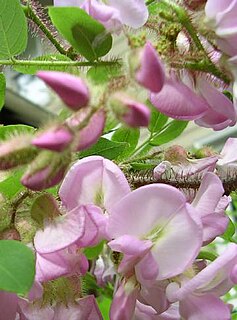
Robinia hispida, known as the bristly locust, rose-acacia, or moss locust, is a shrub in the subfamily Faboideae of the pea family Fabaceae. It is native to the southeastern United States, and it is present in other areas, including other regions of North America, as an introduced species. It is grown as an ornamental and can escape cultivation and grow in the wild.

Nepenthes hispida is a tropical pitcher plant species native to Borneo. It grows at elevations of 100 to 800 m in kerangas forest. It is known with certainty only from Lambir Hills National Park and surrounding areas.
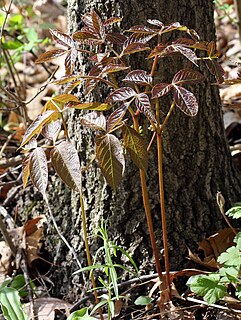
Aralia nudicaulis is a flowering plant of northern and eastern North America which reaches a height of 30–60 cm (12–24 in) with creeping underground stems.

Acalypha hispida, the chenille plant, is a flowering shrub which belongs to the family Euphorbiaceae, the subfamily Acalyphinae, and the genus Acalypha. Acalypha is the fourth largest genus of the family Euphorbiaceae, and contains many plants native to Hawaii and Oceania.

Angophora hispida grows as a mallee, or as a tree to about 7 m (25 ft) in height. A. hispida's small size, especially when compared to its Angophora and Eucalyptus relatives, leads to it being known by the common name dwarf apple. It is native to a relatively small patch of central New South Wales – from just south of Sydney up to the Gosford area. The plant's leaves are sessile (stalk-less) and hug the stem with heart-shaped bases. Its previous name – A. cordifolia – referred to these cordate leaves. Another distinctive feature are the red bristly hairs that cover the branchlets, flower bases and new growth. This leads to the specific epithet hispida.

Gaultheria hispida, commonly known as the copperleaf snowberry, is an endemic eudicot of Tasmania, Australia. It is an erect multi-branched shrub, that can be found in wet forests and alpine woodlands. Its berries appear snowy white and leaves are tipped with a copper tinge, hence the common name.
Phyllostegia hispida, the hispid phyllostegia, is an endangered species of flowering plant in the mint family, Lamiaceae. It is found only in wet forests at elevations of 2,300–4,200 feet (700–1,280 m) on the island of Molokaʻi in Hawaiʻi. This green vine's loosely spreading branches often form a large mass.

Castilleja levisecta is a rare species of flowering plant in the family Orobanchaceae known by the common name golden paintbrush, or golden Indian paintbrush, listed under the Endangered Species Act in 1997. It is native to British Columbia and Washington, where it is known from eleven remaining populations. It occurred in Oregon but all natural occurrences there have been extirpated. It has been reintroduced to a few areas in Oregon, but it remains to be seen if the plants will survive. The plant is a federally listed endangered species of Canada and was listed as threatened in the United States in 1997. On June 30, 2021, the plant was proposed for delisting due to recovery.

Wedelia acapulcensis, commonly known as Acapulco wedelia, is a species of flowering plant in the sunflower family, Asteraceae. It is native to Texas in the United States, Mexico, and Central America.

Smilax tamnoides, common name bristly greenbrier, is a North American species of plants native to the United States and Canada. It is widespread from Ontario and New York State south to Texas and Florida.
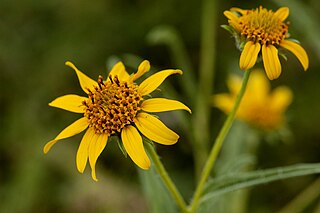
Heliomeris hispida is a North American species of flowering plants in the sunflower family called the hairy goldeneye or rough false goldeneye. It is native to the southwestern United States and also to the northern Sierra Madre Occidental of western Chihuahua and eastern Sonora in Mexico. There are a few reports of the species growing in California, but these are most likely introduced populations.

Wildlife of Finland is affected by prevailing environmental conditions. Phytogeographically, Finland is shared between sosput, central European, and northern European provinces of the Circumboreal Region within the Boreal Kingdom. The territory of Finland can be subdivided into three ecoregions: the Scandinavian and Russian taiga, Sarmatic mixed forests, and Scandinavian Montane Birch forest and grasslands. Taiga covers most of Finland from northern regions of southern provinces to the north of Lapland. On the southwestern coast, south of the Helsinki-Rauma line, forests are characterized by mixed forests, that are more typical in the Baltic region. In the extreme north of Finland, near the tree line and Arctic Ocean, Montane Birch forests are common.

Carex hispida is a species of perennial herb in the family Cyperaceae (sedges). They have a self-supporting growth form and have simple, broad leaves.
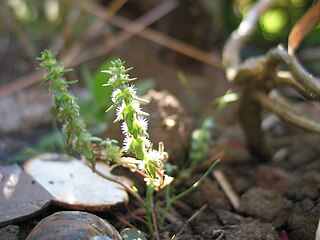
Valantia hispida is a species of annual herb in the family Rubiaceae. They have a self-supporting growth form and simple, broad leaves. Individuals can grow to 0.05 m.
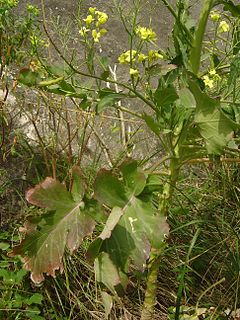
Brassica rupestris is a species of flowering plant in the family Brassicaceae, native to southwestern Italy, and Sicily. The plant is known to grow on vertical limestone cliffs. In the past it was proposed, based on morphology, that Brassica rupestris contributed to the ancestry of either kale or kohlrabi, but DNA evidence shows that it did not.

Castilleja hispida is a species of flowering plant in the family Orobanchaceae, also known by the common name harsh paintbrush, or harsh Indian paintbrush. It is native to British Columbia, Alberta, Washington, Idaho, Montana, and Oregon.


















